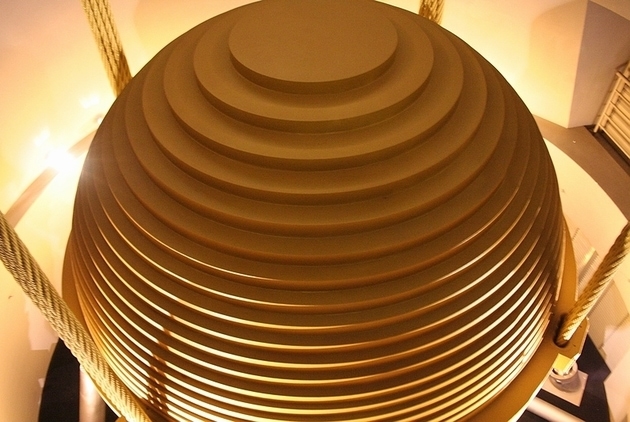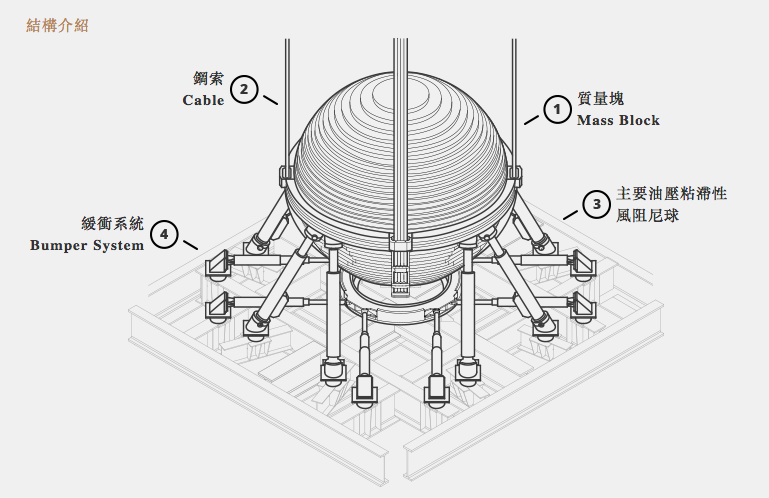Submitted by Michael Frankfort @mfrank_76
What keeps Taipei 101 steady during earthquakes and typhoons?
The giant golden ball prevented people inside the skyscraper from harm or discomfort during earthquakes and typhoons.
By Fang-Yu Chen
web only
2019-04-24

A giant golden ball hangs suspended beneath the observatory deck of Taipei 101. This is the “wind damper.” It generates reaction force to negate shock or vibration caused by outside forces, so people inside the skyscraper can live and work in comfort.
Visitors who’ve been to the Taipei 101 Observatory probably noticed the giant golden orb suspended beneath their feet. It is a “wind damper,” also known as a “tuned mass damper.”
A wind damper is made up of three major components: an oscillating mass (for inertial force), a spring (for elastic restoring force), and a viscodamper (for energy dissipation). At 508 meters in height, the Taipei 101 is a massive skyscraper, and is therefore susceptible to oscillation caused by earthquakes or strong winds.
If the shaking is too violent, office workers and tourists inside the building may experience dizziness and discomfort.
In an article penned by Evergreen Consulting Engineering (永峻工程), which supervised the structural design of Taipei 101, when oscillation caused by wind exceeds 5cm/sec2 , people within the skyscraper will experience discomfort.
However, due to its great height, the vibration experienced by the higher office levels is already 6.2 cm/sec2 in normal weather. The figure shoots up to 7.4cm/sec2 when there’s a typhoon. Both numbers are greater than the recommended 5cm/sec2. Therefore, Taipei 101 needs a wind damper to reduce the vibration caused by high winds.
In fact, many skyscrapers in the world are fitted with wind dampers, such as CN Tower in Toronto, Crystal Tower in Osaka, Centerpoint Tower in Sydney, and Citicorp Center in New York. The 85 Sky Tower in Kaohsiung also has one, as do many high-tech factories. Height is not the only factor; wind speed and oscillation must also be considered.
On September 21st, 2014, Tropical Storm Fung-wong struck Taiwan. The wind damper inside Taipei 101, which was at that time the biggest in the world, experienced a record oscillation of 10 centimeters in both directions between 1:23 and 2:41 in the afternoon.
Currently, the wind damper in Taipei 101 is the second largest in the world. Its diameter measures 5.5 meters, its weight is 660 metric tons. It was made by welding together 41 layers of steel boards, each 12.5 centimeters thick. The cost was 4 million U.S. dollars.
The sheer size and weight of the wind damper made it difficult to move to the construction site, and it was simply impossible for cranes to lift it up to between the 87th and 92nd floors, where it was to be installed. Workers had to send the damper up in smaller pieces, then weld the whole thing together on the spot.
This is one of the only two wind dampers in the world that are open to visitors. Situated between the 87th and 92nd floor, it is an important reason why Taipei 101 is protected against strong winds and earthquakes. It negates up to 40% of the oscillation.
In July of 2013, when Typhoon Soulik made landfall, wind speed in the Taipei area reached Force 14 on the Beaufort scale. At 4:10 in the morning, the wind damper in Taipei 101 experienced an oscillation of 70 centimeters in both directions, the greatest since the building was completed.
On April 18th, 2019, an earthquake measuring 6.1 on the Richter scale struck Xiulin Township in Hualien. At 1:01 in the afternoon, the wind damper in Taipei 101 swung 20 centimeters in both directions, a record-breaking oscillation that’s caused by an earthquake.
This ingenious protection mechanism prevented people inside the skyscraper from harm or discomfort.

Source: Taipei 101
Translated by Jack C.
Edited by Gemma Liu
